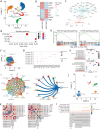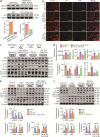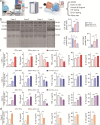TGF-β1 mediates hypoxia-preconditioned olfactory mucosa mesenchymal stem cells improved neural functional recovery in Parkinson's disease models and patients
- PMID: 39034405
- PMCID: PMC11265117
- DOI: 10.1186/s40779-024-00550-7
TGF-β1 mediates hypoxia-preconditioned olfactory mucosa mesenchymal stem cells improved neural functional recovery in Parkinson's disease models and patients
Abstract
Background: Parkinson's disease (PD) is a neurodegenerative disorder characterized by the degeneration of dopaminergic neurons in the substantia nigra (SN). Activation of the neuroinflammatory response has a pivotal role in PD. Mesenchymal stem cells (MSCs) have emerged as a promising therapeutic approach for various nerve injuries, but there are limited reports on their use in PD and the underlying mechanisms remain unclear.
Methods: We investigated the effects of clinical-grade hypoxia-preconditioned olfactory mucosa (hOM)-MSCs on neural functional recovery in both PD models and patients, as well as the preventive effects on mouse models of PD. To assess improvement in neuroinflammatory response and neural functional recovery induced by hOM-MSCs exposure, we employed single-cell RNA sequencing (scRNA-seq), assay for transposase accessible chromatin with high-throughput sequencing (ATAC-seq) combined with full-length transcriptome isoform-sequencing (ISO-seq), and functional assay. Furthermore, we present the findings from an initial cohort of patients enrolled in a phase I first-in-human clinical trial evaluating the safety and efficacy of intraspinal transplantation of hOM-MSC transplantation into severe PD patients.
Results: A functional assay identified that transforming growth factor-β1 (TGF-β1), secreted from hOM-MSCs, played a critical role in modulating mitochondrial function recovery in dopaminergic neurons. This effect was achieved through improving microglia immune regulation and autophagy homeostasis in the SN, which are closely associated with neuroinflammatory responses. Mechanistically, exposure to hOM-MSCs led to an improvement in neuroinflammation and neural function recovery partially mediated by TGF-β1 via activation of the anaplastic lymphoma kinase/phosphatidylinositol-3-kinase/protein kinase B (ALK/PI3K/Akt) signaling pathway in microglia located in the SN of PD patients. Furthermore, intraspinal transplantation of hOM-MSCs improved the recovery of neurologic function and regulated the neuroinflammatory response without any adverse reactions observed in patients with PD.
Conclusions: These findings provide compelling evidence for the involvement of TGF-β1 in mediating the beneficial effects of hOM-MSCs on neural functional recovery in PD. Treatment and prevention of hOM-MSCs could be a promising and effective neuroprotective strategy for PD. Additionally, TGF-β1 may be used alone or combined with hOM-MSCs therapy for treating PD.
Keywords: Autophagy; Hypoxia-preconditioned; Immune regulation; Microglia; Olfactory mucosa mesenchymal stem cells (OM-MSCs); PI3K/Akt signaling pathway; Parkinson’s disease (PD); Transforming growth factor-β1 (TGF-β1).
© 2024. The Author(s).
Conflict of interest statement
The authors declare that they have no competing interests.
Figures








References
Publication types
MeSH terms
Substances
Grants and funding
- 2020SK2102/Key Research and Development Program of Hunan Province of China
- No.2023JJ40420/Supported by Hunan Provincial Natural Science Foundation of China
- kq2208154/Supported by Changsha Municipal Natural Science Foundation
- B202304088074/Scientific Research Project of Hunan Provincial Health Commission
- 202203105045/Scientific Research Project of Hunan Provincial Health Commission
LinkOut - more resources
Full Text Sources
Medical

